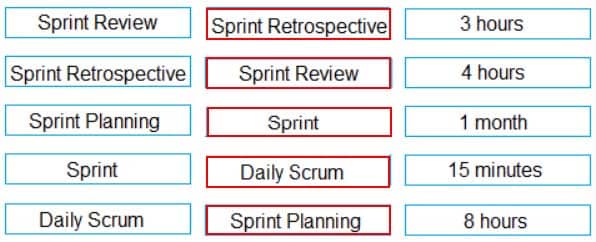PMI-ACP : PMI Agile Certified Practitioner : Part 23
-
If the Sprint Backlog cannot be completed in a Sprint, who resolves the issue?
- Product Owner
- Scrum Master
- Development Team
- Both the Product Owner and Development Team
-
If a customer really wants a feature added to a Sprint, how should the Development Team respond?
- Add the feature into the current Sprint backlog
- Escalate to the Scrum Master
- Add the item to the Product Backlog for prioritization in the next Sprint
- Ask the Product Owner to work with the customer
-
When does a Sprint get canceled or end early?
- When the Sprint backlog is complete
- When the Sprint Goal cannot be met
- When the definition of “Done” is met
- When a key resource is out sick
-
How long is the time-box for the daily Scrum?
- It depends
- 5 minutes per person on the Development Team
- 15 minutes
- Whatever the Team decides
-
How does the Scrum Master provide the most value to the Team?
- By facilitating discussions between the Product Owner and the Development Team
- Ensuring time-boxes are kept
- Removing impediments to the Development Team
- Scheduling Scrum events
-
Select the statements that are TRUE about the Product Owner. (Choose two.)
- The Product Owner can clarify the backlog during the Sprint
- The Product Owner estimates the size of the Sprint backlog
- The Product Owner prioritizes the Product backlog
- The Product Owner defines the Sprint Goal before the Sprint Planning meeting
-
Who creates the Sprint Goal?
- The Development Team
- The Scrum Master
- The Product Owner
- The entire Scrum Team
-
In Scrum, the development team decides which events or ceremonies take place during a Sprint.
- True
- False
-
The Scrum Master is a participant in the Sprint Retrospective.
- True
- False
-
If the Development Team does not have all the skills to accomplish the Sprint Goal, the Scrum Master should:
- Cancel the Sprint
- Stop using Scrum
- Have the development team determine the definition of “Done” and work through the Sprint backlog
- Remove the impacted stories from the Sprint backlog
-
The Project Manager plays the following role in Scrum:
- Collects the status from the Scrum Master
- Updates the Burndown chart
- Creates the release plan
- There is no project manager role in Scrum
-
What is the purpose of the Sprint Review? (Choose three.)
- To collaborate with stakeholders
- To inspect and adapt
- To provide status on the Sprint
- To demonstrate what is “Done”
-
Scrum dictates the use of User Stories.
- True
- False
-
Scrum is a software development methodology.
- True
- False
-
If the Development Team doesn’t like the time of the daily Scrum, what should the Scrum Master do?
- Find a time that is open on everyone’s calendar
- Let the Development Team come up with a new time
- Ask the Team to try the existing time for one Sprint
- Tell them that Scrum is immutable and that they need to stick to it
-
The backlog is ordered by:
- The needs of the Product Owner
- Risk
- Complexity
- Size
-
Who is responsible for maximizing the value of the product backlog?
- The Customer
- The Scrum Master and Product Owner
- The Product Owner
- The Development Team and Product Owner
-
What happens if all the necessary testing doesn’t occur in a Sprint?
- The User Story is moved to the next Sprint
- Additional testers are added in the next Sprint
- A risk of not creating a potentially shippable product occurs
- The Burndown chart is updated
-
Pick roles that support the Scrum Master in removing impediments. (Choose two.)
- The Development Team
- Senior Management
- The Product Owner
- The Customer
-
DRAG DROP
Match each of the following items with its associated time-boxed duration for a one-month Sprint.

PMI-ACP PMI Agile Certified Practitioner Part 22 Q20 031 Question 
PMI-ACP PMI Agile Certified Practitioner Part 22 Q20 031 Answer Explanation:
Sprint Review – 4 hours
Sprint Retrospective – 3 hours
Sprint Planning – 8 hours
Sprint – 1 month
Daily Scrum – 15 minutes
Subscribe
0 Comments
Newest